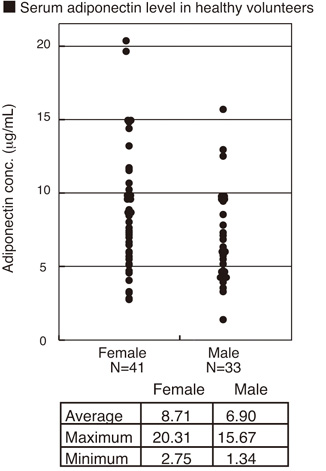CircuLex Human Adiponectin ELISA Kit
Product Code:
MBL-CY-8050
MBL-CY-8050
Host Type:
Human
Human
Regulatory Status:
RUO
RUO
Application:
Enzyme-Linked Immunosorbent Assay (ELISA)
Enzyme-Linked Immunosorbent Assay (ELISA)
Shipping:
4°C
4°C
Storage:
4°C
4°C
No additional charges, what you see is what you pay! *
| Code | Size | Price |
|---|
| MBL-CY-8050 | 96 Assays | £509.00 |
Quantity:
Prices exclude any Taxes / VAT
Stay in control of your spending. These prices have no additional charges, not even shipping!
* Rare exceptions are clearly labelled (only 0.14% of items!).
* Rare exceptions are clearly labelled (only 0.14% of items!).
Multibuy discounts available! Contact us to find what you can save.
This product comes from: United States.
Typical lead time: 10-14 working days.
Contact us for more accurate information.
Typical lead time: 10-14 working days.
Contact us for more accurate information.
- Further Information
- Documents
- References
- Show All
Further Information
Background:
Adiponectin, also referred as Acrp30, AdipoQ and GBP-28, is a recently discovered 244 aminoacid protein, the product of the apM1 gene, which is physiologically active and specifically and highly expressed in adipose cells (adipokine). The protein belongs to the soluble defence collagen superfamily; it has a collagen-like domain structurally homologous with collagen VIII and X and complement factor C1q-like globular domain (1, 2). Adiponectin forms homotrimers, which are the building blocks for higher order complexes found circulating in serum (3, 4). Circulating Adiponectin levels are high (5-30 g/mL), accounting for approximately 0.01% of total plasma protein (5-8). Adiponectin receptors AdipoR1 and AdipoR2 have been recently cloned; AdipoR1 is abundantly expressed in skeletal muscle, whereas AdipoR2 is predominantly expressed in the liver (9). Paradoxically, adipose tissue-expressed adiponectin levels are inversely related to the degree of adiposity (10,11). A reduction in adiponectin serum levels is accompanied by insulin resistance states, such as obesity and type 2 diabetes mellitus (12, 13). It is also reported in patients with coronary artery disease (13). Increased adiponectin levels are associated with type 1 diabetes mellitus, anorexia nervosa and chronic renal failure. Adiponectin concentrations correlate negatively with glucose, insulin, triglyceride concentrations and body mass index and positively with high-density lipoprotein-cholesterol levels and insulin-stimulated glucose disposal. Adiponectin has been shown to increase insulin sensitivity and decrease plasma glucose by increasing tissue fat oxidation. It inhibits the inflammatory processes of atherosclerosis suppressing the expression of adhesion and cytokine molecules in vascular endothelial cells and macrophages, respectively. This adipokine plays a role as a scaffold of newly formed collagen in myocardial remodelling after ischaemic injury and also stimulates angiogenesis by promoting cross-talk between AMP-activated protein kinase and Akt signalling in endothelial cells (14).
Injection of Adiponectin into non-obese diabetic mice leads to an insulin-independent decrease in glucose levels (15). This is likely due to insulin-sensitizing effects involving Adiponectin-regulation of triglyceride metabolism (15). A truncated form of Adiponectin (gAdiponectin) containing only the C-terminal globular domain has been identified in the blood, and recombinant gAdiponectin has been shown to regulate weight reduction as well as free fatty acid oxidation in mouse muscle and liver (16, 17). The full-length recombinant Adiponectin protein is apparently less potent at mediating these effects (16, 17).
Description:
The CycLex Research Product Circulex Human Adiponectin ELISA kit is used for the quantitative measurement of human Adiponectin in serum, plasma, tissue culture medium and other biological media.
Gene IDs:
Human: 9370 Mouse: 11450
Kit Components:
Microplate, 10X Wash Buffer, Dilution Buffer, Human Adiponectin Standard, HRP conjugated Detection Antibody, Substrate Reagent, Stop Solution
Measurement Range:
Dilution factors need to be taken into consideration in calculating the Adiponectin concentration. Results exceeding Adiponectin level of 32 ug/ml should be repeated with diluted samples.
Sensitivity:
better than 1.46 ng/ml of sample.
Target:
ADIPOQ
Documents
References
1. Maeda, K. et al.(1996) Biochem. Biophys. Res. Commun. 221:286.
2. Kishore, U. and K.B. Reid (2000) Immunopharmacology 49:159.
3. Shapiro, L. and P.E. Scherer (1998) Curr. Biol. 8:335.
4. Nakano, Y. et al.(1996) J. Biochem. (Tokyo) 120:803.
5. Scherer, P.E. et al. (1995) J. Biol. Chem. 270:26746.
6. Fruebis, J. et al. (2001) Proc. Natl. Acad. Sci. USA 98:2005.
7. Berg, A.H. et al. (2002) Trends Endocrinol. Metab. 13:84.
8. Arita, Y. et al. (1999) Biochem. Biophys. Res. Commun. 257:79.
9. Yamauchi, T. et al.(2003) Nature 423:762.
10 Stefan, N. et al.(2002) J. Clin. Endocrinol. Metab. 87:4652.
11. Matsubara, M. et al.(2002) Eur. J. Endocrinol. 147:173.
12. .Weyer, C. et al. (2001) J. Clin. Endocrinol. Metab. 86:1930.
13. Hotta, K. et al. (2000) Arterioscler. Thromb. Vasc. Biol. 20:1595.
14. Tomas, E. et al.(2002) Proc. Natl. Acad. Sci. USA 99:16309.
15. Berg, A.H. et al.(2001) Nat. Med. 7:947.
16. Fruebis, J. et al. (2001) Proc. Natl. Acad. Sci. USA 98:2005.
17. Yamauchi, T. et al.(2001) Nat. Med. 7:941.



